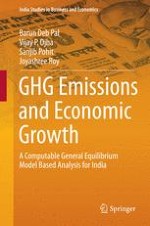2015 | OriginalPaper | Chapter
6. An Environmental Computable General Equilibrium (CGE) Model for India
Authors : Barun Deb Pal, Vijay P. Ojha, Sanjib Pohit, Joyashree Roy
Published in: GHG Emissions and Economic Growth
Publisher: Springer India
Activate our intelligent search to find suitable subject content or patents.
Select sections of text to find matching patents with Artificial Intelligence. powered by
Select sections of text to find additional relevant content using AI-assisted search. powered by
